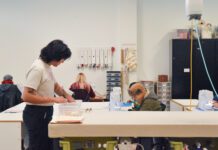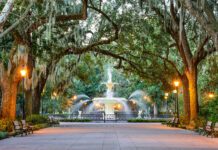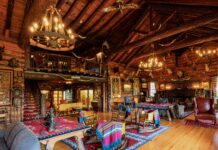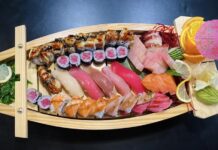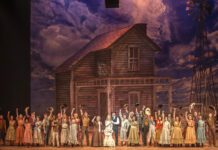Tucked away behind a swath of local eateries along 23rd Street, Guernsey Park isn’t necessarily hidden, but a few wrong turns are de rigueur in finding this new gem. An Asian fusion restaurant helmed by local chef Vuong Nguyen, who trained under Chef Kurt Fleischfresser in The Coach House Apprenticeship Program, Guernsey Park marries the traditional flavors of Asian cuisine with accessible food: think Chinese five-spice chicken legs served with mashed potatoes and oxtail ravioli. Curry salmon, sauerkraut fried rice and seared scallops are popular menu items. Guernsey Park also offers traditional Asian dishes with a distinct, gourmet spin. The Thit Kho Tau, a pork-and-egg dish that is traditionally braised in a caramel sauce and served with white rice, is given a modern makeover, the dish deconstructed and served with pickled vegetable garnish. The flavors perfectly represent Guernsey Park: bright, unexpected and fearless. 2418 N. Guernsey Ave., Oklahoma City. 405.605.5272
Fit for an Oil Baron
In 2002, Mathew Brainerd bought and renovated the 1200 N. Peoria building that originally housed Waite Phillips Oil Company for his Brainerd Chemical Company corporate headquarters. A decade later, when his company needed more space, Brainerd started looking around Tulsa.
“I went to the Philtower just out of curiosity because of the Waite Phillips connection,” says Brainerd. “After seeing some of the lower floors, I was taken to the penthouse, and when I saw Waite Phillips’ office, I immediately knew this is where I wanted to be.”
Brainerd secured a 20-year lease on the top three floors and started an 18-month renovation. The space had been occupied by other notable Tulsans over the decades and had undergone numerous renovations that demolished most of the original finishes. Architect Danny Mitchell was hired to get the office space up to code, but when it came to reconstructing the space, Brainerd turned to Margaret Ferrell, owner of Margaret Ferrell Design.
“Our main goal was to make the lobby and Waite’s personal office on the 21st floor as close as possible to the black-and-white photos provided by Philbrook Museum,” explains Ferrell. The other two floors were designed in the spirit of that era, but they still needed to function as a working space with office cubicles.
Waite’s office was the least changed, according to the photos, although wood paneling covered a wall of tile surrounding the fireplace, and there was wall-to-wall carpeting. Ferrell was thrilled when she discovered a small piece of original floor tile hidden under the wall-enclosed radiator, allowing her to have matching tile custom made with an old world finish by Walker Zanger. Dale Gilman, owner of Antique Warehouse by Dale Gilman, used the existing office chandelier design to create wall sconces as well as additional chandeliers throughout the space. “What impressed me the most was the reproduction of the fireplace screen,” says Brainerd. The detailed copper and bronze screen, painstakingly created by metal crafter Tom Barber, was based on a faded black-and-white, 85-year-old photo.
Ferrell searched for matching furniture but ultimately hired Bill Lawrence of William & Wesley Company in Dallas to reproduce the hand-carved walnut pieces. “Obviously, Waite didn’t have a computer on his desk, so we put Mat’s two computers side-by-side on a mechanical lift that lowers into the desk,” says Ferrell. Brainerd also requested a television; it was framed with distressed wood, and it loops historic photographs of Waite Phillips’ life and early-day Tulsa.
Some of the original items from the office were relocated to the Philmont Scout Camp or given to family members. “I looked for a reproduction of the bronze bust on the fireplace mantel, assuming it was a Nubian bust, popular during that period after the discovery of King Tutankhamun’s tomb,” explains Ferrell. She discovered the bronze on display at Philbrook Art Museum. The bust is of Waite’s wife Genevieve and was sculpted by their daughter.
There was no way to match the lobby tile exactly since the photos were in black and white, so Ferrell used the same color palette as the tile in Waite’s office. She commissioned Zanger to produce the base tile and had tile artist Ronda Roush hand-paint each of the designs with one change. The classic Native American “Whirling Log” symbol was included in the 1928 tile design. However, in the 1930s, the symbol was flipped and became known as the Swastika used by Nazi Germany. “In good conscience, I just could not use that design,” says Brainerd. So, because of Waite Phillips’ support of the Boy Scouts, the organization’s symbol was substituted.
Brainerd’s goal was to recreate the historic space as a gift to Tulsa and has welcomed visitors. Recently, a national group of Boy Scout officials toured the office, including Waite’s granddaughter and great-grandchildren.
“I still refer to it as Waite’s office,” laughs Brainerd who says he is honored to be the caretaker.
The Name Game
Did you ever consider how tough it must be to come up with titles for songs that don’t have any words? While some great instrumentals are blessed with names that describe them perfectly – Santo & Johnny’s “Sleepwalk,” Link Wray’s “Rumble,” Leon McAuliffe’s “Steel Guitar Rag” and Count Basie’s “One O’Clock Jump,” for instance – many others are named for arcane references or obscure in-jokes and don’t really indicate musical content.
In his long and impressive career as a fiddle, mandolin and guitar player, Tulsa’s Shelby Eicher has written more than his share of instrumental numbers. He’s also good at coming up with titles that describe the sound.
Naming his new band, however, was a different story.
“When you name a group, it’s like writing a song,” he says. “Either you have the spark idea, and it flows right out, or you say, ‘Okay, I’ll keep working on it,’” he explains. “So we spent six months or so just hammering on it: ‘No, that sounds too cheesy. No, that one doesn’t work.’
“Then, I was talking to [fellow Tulsa fiddler] Rick Morton, and he said, ‘You’re so good at naming tunes; the name always sounds like what the music sounds like.’ I said, ‘Yeah. You know when I wrote that tune “Mischievous Swing,” I named it that because it just had a kind of mischievous sound.’
“He said, ‘That’s the name of your band right there.’ I said, ‘But that’s the name of a tune.’ He said, ‘That’s okay.’”
So Eicher returned to his bandmates – sons Isaac (mandolin) and Nathan (bass) along with their contemporary Ivan Pena (guitar) – and related what Morton had told him.
“They said, ‘Well, yeah,’” recalls Eicher with a chuckle. “So I’m not going to say we were named by default, but it took a long time to figure out that, ‘Hey, we already have this name, it’s really cool, and it’s what the group sounds like.’”
The fact that the term also conjures up, in some music lovers’ minds, images of the sly gypsy-jazz virtuosos Django Reinhardt and Stephane Grappelli and their revered ‘30s outfit, the Hot Club of France is also appropriate. One listen to Mischievous Swing’s new eponymously titled CD is all you need to hear the connection. As was the case with the music of guitarist Reinhardt and violinst Grappelli, this is high-energy string-band jazz and swing, complex and arresting, fiery and sure-handed. It’s the kind of sound that comes from people who have been playing together for years, taking off into different musical directions, exploring new horizons.
Eicher, who grew up in Ohio playing square dances and other events with his parents and grandmother, got to string jazz via bluegrass, with stops in-between for western swing and Dawg music, the musical fusion created in the ‘70s by mandolinist David Grisman and his quintet.
“They used bluegrass instruments – two mandolins, a fiddle, guitar and bass – but they had jazz sensibilities,” he says of Grisman’s group. “They fused gypsy music, Latin music, klezmer and really created something unique. Around 1978, I got turned onto [the Grisman album] Hot Dawg, That had some Stephane Grappelli on it and I thought, ‘Oh, my gosh. Whoever this is, he’s way above everyone else. That was my first exposure to him – and to jazz, really.”
Eicher ultimately went to work in Roy Clark’s band, a position he would hold for many years. But his love for jazz continued unabated.
“Even when I was with Roy, I’d go play with [legendary Tulsa jazz guitarist] Randy Crook,” he remembers. “And I was studying Charlie Parker, you know. I’d meet up with the guys in the band and they’d ask me, ‘What are you listening to?’” He laughs. “They’d be listening to the commercial music, which is fine, but it was like learning to make McDonald’s hamburgers. The other way, you’re trying to be like a gourmet French chef.
“I think it was just the jazz music itself that intrigued me,” he adds. “Of course, Janet sings jazz, you know, so we always had that kind of thing going on.”
“Janet” is the well-known area vocalist Janet Rutland, who’s been married to Eicher for many years. They are the parents of Nathan and Isaac and a third son, Paul, who plays guitar as a sideline while holding down a full-time job as an academic advisor at Tulsa Community College.
“The boys and I used to just play around the house, and every now and then, as they got older, we’d do some shows with Janet,” Eicher says. “Over the years, we had kids in football, in debate tournaments, and I was working full-time with [guitarist] Mark Bruner, so there really weren’t a lot of opportunities for us to work shows together. Then the kids went off to college and we started playing together less. It’d only be on a holiday or something, or two of us would play and the others wouldn’t be here.”
Then, bassist Nathan finished his education by getting a master’s degree in jazz from the University of Central Oklahoma, and Isaac, a national championship mandolin player, returned from a stint at a college in Spain, where, his father notes, “he really started focusing on people like the Rosenberg Trio, gypsy guys who play like Django.” Isaac also began playing regularly in Norman with guitarist Pena.
“After Isaac got back from Spain, we were kind of talking about this whole thing,” Eicher says. “Nathan’s really into jazz now, and we had a real focus, something that we really wanted to do. And we thought if we were going to do something gypsy-esque, maybe Ivan would like to do it.”
It turned out that he would indeed, and the members of Mischievous Swing began working together in earnest the last couple of months of 2012. Since then, the group has played a number of engagements, including a well-received appearance at the East Coast Django Gypsy Fest in Pennsylvania, and recorded the Mischievous Swing CD, which features one Isaac and four Shelby Eicher originals along with versions of jazz and swing classics ranging from “Honeysuckle Rose” to Dave Brubeck’s “Take Five” and Chick Corea’s “Spain.” A release party is planned for later in August at the Oklahoma Jazz Hall of Fame in Tulsa.
“I think the other influence we have besides swing and gypsy music and modern jazz, whatever that is, is Latin,” says Eicher. “Isaac’s tune, ‘Valencia,’ is somewhat Brazilian, and then we’ve done a bossa nova. And when you get to ‘Spain,’ that’s a samba rhythm. We really like the mixture of grooves.”
Although the players who make up Mischievous Swing are working musicians with other regular gigs – Shelby, for instance, continues his 17-year association with Mark Bruner in a trio with vocalist Annie Ellicott, along with leading the western-swing band the Tulsa Playboys – they can see the potential this act has to be something special. So can Roy Clark, to whom the group gave a private show in his Tulsa office.
“Roy called me the next day, and he was so excited,” Shelby says. “He said, ‘I was absolutely blown away. The musicianship and the music – I have no words to say how great it was.’ I thought that was a really nice compliment.
“I think our show’s exciting,” he concludes. “I think it’s fun to watch. And, you know, it’s always fun to play with your kids.”
For The Birds
The grassroots organization Quail Forever is aptly named. Since its 2005 launch, the Oklahoma chapter of this international organization, one of the first in the country, has worked to save and protect the game bird and preserve its habitat – not just in the short-term, but forever.
Quail Forever’s mission is to improve habitat, increase public awareness and advocate sound land management policies for quail, and all upland birds, on a local scale.
But why are these creatures, somewhat diminutive and mostly flightless, so crucial to protect?
Laura McIver, president of the Central Oklahoma ‘89ers Chapter of Quail Forever, says that these birds are more important to Oklahoma than many might realize.
“Quail actually represent a much larger ecosystem that is sadly disappearing from our plains,” McIver says.
Bobwhite quail and other prairie birds, she adds, could easily become threatened species unless action is taken.
“We are in a critical stage for quail,” McIver says. “The drought exacerbated population loss, but so many other factors are also threatening their future. There has been a tremendous loss of habitat due to things like urban sprawl, intensive farming practices, a takeover of prairie grasses by forests and grasses that don’t benefit quail.”
Luckily, Quail Forever, with its unique grassroots structure, is here to help.
McIver says that the group’s fundraising model is one big reason why she spends so much time with Quail Forever. Unlike other wildlife conservation groups, the local volunteers who raise money have control over the funds.
“So, they have a major say in where their fundraising dollars are spent,” she says.
What began as a group of only six or so dedicated group members in 2005 grew into a regular, core group of 17 board members and volunteers. Fundraising events also became larger and more involved, beginning with just one banquet a year; the group now hosts numerous events.
Founding chairman, James Dietsch adds that these events are critical to help the group reach their goals.
“[Our chapter] has already spent over $125,000 on conservation efforts and education in Oklahoma,” Dietsch says. “Our goal is to help bring back quail populations in order to preserve the heritage that has been established since the 1930s.”
One such conservation effort was the recent project in the Packsaddle Wildlife Management Area in Ellis County. McIver says that funds were used to remove several miles of fencing in order to facilitate a controlled burn, causing a wider variety of grasses and vegetation mixes to grow – a beneficial move for quail.
“The fence removal also helps hunter access and contributes to a more positive hunting experience,” McIver says.
It might seem ironic to some, but McIver says that most of the Quail Forever group are hunters.
“Hunters are actually our greatest conservationists,” she explains.
McIver points out that hunting is a great management tool, and that through the Pittman-Robertson Act, an excise tax on hunting equipment means that hunters fund most environmental conservation throughout the country.
Dietsch also says that the quail hunting heritage is a big part of Oklahoma’s history.
“Quail are native to Oklahoma and are a symbol of a healthy prairie and environment,” Dietsch says. “Quail and quail hunting in Oklahoma is a tradition that has been shared by many families for many years and it would be very disappointing to lose that tradition.”
West World
Settle into your accommodations in the quaint, scenic town of Jackson, Wyo., and stroll to the heart of town and Town Square. Uniquely appointed with arches made of hundreds of elk antlers, this true heart of town is also the civic center of Jackson, and many of the eclectic and interesting shops are immediately adjacent to the Square. While much of your Jackson Hole adventure will take place outside of town, exploring Jackson itself is worthwhile.
Saturday morning, you will want to consult your individual itinerary. Two of the world’s most spectacular parks are within easy travel, so you will want to have planned how to see your preferred aspects of Yellowstone National Park and Grand Teton National Park in the most efficient time frame possible. Pick up a picnic lunch, or pack your own, and take to these unique and famed American settings. Both parks offer incredible outdoor sporting, hiking, wildlife watching, photography and more, and your park itinerary should reflect weather conditions and season. Alternate spectacular outdoor sites that might make your agenda include the National Elk Refuge with its fantastic December-April horse-drawn sleigh rides. You will have worked up an appetite by the time you return to town from the parks, so consider a hearty burger from The Bird or enjoy the upscale American cuisine at The Kitchen.
If more outdoor adventure is appealing Sunday, consider visiting Jackson Hole Ski Resort for skiing, paragliding or any of several other fun seasonal activities. Alternately, visit the Jackson Hole Museum where more than 12,000 artifacts help tell the story of the town, region and nearby national parks. The National Museum of Wildlife Art is another terrific possibility, and the RARE Gallery Jackson Hole Arts houses western contemporary art from some of the greats of the genre. Spend the rest of your day strolling the town’s galleries and shops, and complete the visit with dinner at The Spur Restaurant & Bar at the Teton Mountain Lodge or at the quaint Café Genevieve in downtown Jackson.
Stay In Style
Four Seasons Resort Jackson Hole’s 124 guest rooms and suites in a mountain retreat atmosphere provide an evocative setting, complete with a gas fireplace, residential-style furnishings, dark wood and natural stone finishes with leather insets. The ski-in, ski-out environment is amenable year-round to easily accessible outdoor sports, while scenic rooms are also equipped to permit guests to stay in touch with business interests. www.fourseasons.com
Amangani is a luxurious resort sporting spectacular views and providing a famed level of service to guests of the 40 rooms at this beautiful mountain setting. Incredibly attentive service pairs with comfort, a beautiful pool and some of the best wildlife watching of any hotel or resort in the region. www.amanresorts.com/amangani
Rusty Parrot Lodge and Spa is a beautiful boutique setting just a few minutes’ walk from the heart of Jackson, but also seemingly miles removed from the world. Luxury and pampering abound in each of the individually appointed rooms, including the finest linens, plush towels, soft terry robes and slippers, deep tubs, L’Occitane bath amenities, flat panel satellite television and free wireless internet. www.rustyparrot.com
Hot Picks
Hold the “Hole”: Remember while speaking to people in town that you are in Jackson, Wyo. Jackson Hole refers to the greater valley area.
Llama: Wildlife and nature lovers might enjoy a day trip with Jackson Hole Llamas for a unique look at the spectacular countryside.
Spa: The Jackson area is home to a number of day spas that offer pampering and wellness in between or in lieu of vaunted local outdoor recreation.
Visit Online
Cold War Kids
The Los Angeles boys of Cold War Kids return to Oklahoma for a night of raw melodies and heart-pumping drumbeats. The band first appeared in 2006 with the breakthrough LP Robbers & Cowards, fronted with the popular songs “Hair Down” and “Hang Me Out to Dry.” After two more albums, the world was forced to wait two years for another studio release from the indie rock quartet. Armed with a new guitarist and deeper stories to tell, the April 2013 release of Dear Miss Lonelyhearts gave fans ten tracks of fresh music evolved from their signature and well-known sound. Cold War Kids make a stop on their North American tour at Cain’s Ballroom, 423 N. Main St., in Tulsa on Wednesday, Aug. 21. The show is scheduled for 8 p.m. with doors opening at 7 p.m. Tickets are $19-$35 each, available at the Cain’s Ballroom box office or online at www.cainsballroom.com.
Special Report: Education
The Digital Classroom
As more higher education programs move online, classroom doors are opening for students of all stripes.
Global Leaders
Oklahoma schools look to the future to create some of the most innovative programs on the planet.
The Master Plan
Demystify the college search process.
Scoring Success
Standardized testing in Oklahoma schools is always evolving.
Private Matters
Choosing the correct private school for your child is vital in achieving the best education.
Going Places
If these 2013 graduates from Oklahoma high schools are any indication, the state’s future will be very bright.
More Than A Game
In the lyrics to the song, “The Lower 48,” by alternative country band The Gourds, singer Kevin Russell assigns brief, one or two sentence descriptions to each of the 48 contiguous states. When he comes to Oklahoma, he sings “Oklahoma is a dirty red mean/Native American slot machine.” As with most songs by the band, Russell sings the lyrics with a twinkle in his eye and his tongue planted in his cheek. But the line also reflects a wider perception of Oklahoma, that of a state that is heavily populated by American Indians and whose economy is primarily fueled by casinos.
Data from the 2010 U.S. Census shows 321,687 Oklahomans identified as Native American, or about nine percent of the state’s total population, good for third among the state’s racial groups, after white and Hispanic/Latino. Not bad, but not exactly as the song would suggest. As for casinos, they are definitely becoming a more common sight across the state, and they are an increasingly vital component to the state’s economy. But they are only one part of the growing network of Native American tribal businesses that are helping to make Oklahoma’s economy one of the healthiest in the nation.
Diverse Interests
“We’re much more than just a gaming tribe,” says Judy Allen, public relations director for the Choctaw Nation. “We’ve got a tremendous focus right now on culture and heritage job development and diverse markets. For instance, one of the things that we’re doing is a large print business here in the Choctaw Nation. We were named one of the top 400 printing businesses this year with Texoma Print Services.”
The idea of expanding beyond established economic opportunities has become a routine practice among Oklahoma tribes. It’s a practice that is benefitting the individual tribes and their surrounding communities, as each business entity creates jobs for Oklahomans.
“One of the things we’re doing is looking really hard in the areas of government contracting, especially with 8A,” says Creek Nation Chief George Tiger, referring to the federal business development program. “We haven’t been as aggressive as we should be. And we’re certainly going to be doing that because I believe we’ve missed out for too long. 8A is something that a number of tribes are getting involved with.”
Oklahoma Native American tribes are diversifying. Health care has always been a major focus of tribal economies, but tribes are now expanding into telecommunications, manufacturing and production, aerospace and oil and gas services. Any industry that gives a tribe a chance to grow economically is a target. Even sweets.
“We have a chocolate, confectionary business that decorates chocolates. We just built a new plant, relocating from our site near Pauls Valley to a brand new plant at the intersection of I-35 and State Highway 7,” says Neal McCaleb, Chickasaw Nation Ambassador at Large and Chairman of the Board of Chickasaw Nation Industries. “The tribe has other economic enterprises besides gaming, like our bank, which has been very successful. We’re the second largest lender through the FHA 184, which is a special FHA program for Native Americans. We are second only to Wells Fargo, which is a huge bank, and ours is just a little community bank.”
“In our other businesses (besides gaming) we had a 60 percent increase last year,” says Cherokee Chief Bill John Baker. “We are diversifying, we are doing a better job at our outside businesses. We averaged over a million dollars a day in our 8A businesses and outside contracts last year alone.”
Major Impact
In October 2012, Oklahoma City University’s Steven C. Agee Economic Research and Policy Institute published The Statewide Impacts of Oklahoma Tribes. According to the study, the 38 federally recognized Native American tribes in Oklahoma combined to generate $10.8 billion to the state’s economy, or roughly seven percent of the state’s $148 billion in economic production. Tribal entities employ more than 50,000 Oklahomans, both tribal members and non-members, with payroll figures in excess of $1.5 billion. These figures represent tribal entities, but not privately owned Native American businesses, such as TERO contractors, who are largely Native American owned and who largely employ Native American workers.
“We’ve got a new housing program that we’re literally trying to build 100 percent with Cherokee contractors, Cherokee materials, Cherokee everything,” says Baker. “And it’s going to have a huge economic impact that is really outside of the government.”
“We don’t count those TERO dollars in our economic impact, but clearly that’s Native American in a ripple effect,” adds Amanda Clinton, Cherokee Nation communications director.
Gaming Pays Off
Still, in the end, the largest economic impact remains the gaming industry, which includes the casinos, casino hotels and resorts. According to the Steven C. Agee report, gaming generates an estimated $4.8 billion in revenue, more than six times that of all other tribal industries combined.
“We’re taking the next $100 million from gaming, and we’re going to build a new hospital, add on to two clinics and build two brand new clinics that won’t be financed, and there will be no payback on,” Baker says. “And we can make health care in the Cherokee Nation world class by making this $100 million investment.”
Across the state, Native American-owned casinos have emerged as leading destinations for visitors from around the country. Major gaming facilities include the Cherokee Nation’s Hard Rock Hotel and Casino in Catoosa, Winstar World Casino in Thackerville and Riverwind Casino in Norman operated by the Chickasaw Nation, the Muscogee (Creek) Nation’s River Spirit Casino in Tulsa, Downstream Casino & Resort operated by the Quapaw Tribe, the Citizen Potawatomi Nation’s Grand Casino in Shawnee and the Osage Nation’s Osage Casinos. And there are dozens of smaller gaming facilties throughout the state.
As gaming has become the most vital fuel in the economic growth of Oklahoma’s Native American tribes, the tribes themselves have become experts in the gaming industry.
“The Cherokees, we’ve always tried to be top of the market,” says Baker. “We’ve tried to be in front of everybody else. We always try to have the absolute best entertainment experience. We try to have the best hotel rooms. If folks are going to come, and it’s going to say Cherokee, then we want it to be the absolute top of the market.”
That quest for excellence drove the Cherokees to adopt the Hard Rock brand in 2009 along with a host of upgrades to the Catoosa location. Other tribal governments are also doing their homework and strategically expanding gaming operations in ways that make the most economic sense and serve to expand, rather than saturate the gaming market.
Muscogee (Creek) Nation Casinos recently announced a $250 million dollar deal with Margaritaville to bring that brand to its Arkansas River property in Tulsa. The project will dramatically transform the area with a new casino and 22-story, 500 room hotel and a theater and event center among other amenities.
Osage Casinos, which contributed a record $38 million to the tribe in 2012, has adopted a plan to expand all seven of its casinos, spending around $9 million on each facility over the next several years. The flagship Tulsa location has received upgrades, while the Sand Springs facility got a major makeover, including a new bar and dance floor and sit-down restaurant. Construction is under way in Skiatook and Ponca City to dramatically reinvent those properties with expanded casinos, and full-service hotels.
The Quapaw Tribe recently completed expansions to Downstream Casino, which straddles the Oklahoma, Missouri and Kansas borders and draws customers from a broad geographical region. The Kappa Tower expansion added 152 rooms, including 16 luxury suites to the casino’s inventory, along with a new spa and indoor swimming pool.
Just north of the Oklahoma-Texas border, the Chickasaw Nation is rapidly expanding what is already the world’s third largest casino, continuing to play on the luxury global travel theme that has already served it well. The Winstar World Casino unveiled a new entry, Paris-themed casino and several new amenities late last year, and construction of an additional, 18-story, 500-room hotel is in the final stages.
The Citizen Potawatomi Nation has also upgraded its major casino property just outside of Oklahoma City in Shawnee. The tribe rebranded the facility as the Grand Casino Resort last year and opened the full-service, 262-room Grand Hotel in July. Construction is also underway on new dining options, a pool and lounge and a 2,500-seat event center.
These are only a few examples from some of the larger facilities around the state. There have also been significant additions at smaller casinos and gaming centers in every corner of Oklahoma. The growth of gaming and the bullish expansion in a broad spectrum of industries point to a bright outlook for Oklahoma’s native tribes and likely a growing share of the state’s economic output.



